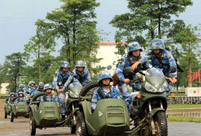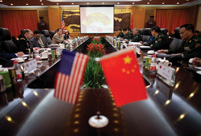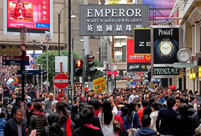 'Jin' named the word of the year by cross-strait netizens
'Jin' named the word of the year by cross-strait netizens Chinese scientific expedition goes to build new Antarctica station
Chinese scientific expedition goes to build new Antarctica station
 Chinese naval escort fleet conducts replenishment in Indian Ocean
Chinese naval escort fleet conducts replenishment in Indian Ocean 17th joint patrol of Mekong River to start
17th joint patrol of Mekong River to start China's moon rover, lander photograph each other
China's moon rover, lander photograph each other Teaming up against polluters
Teaming up against polluters
Let's find the clue to the question from what are happening in Dongjin New District.
The drizzle falling to Xiangyang in July brings rare serenity to the construction site in Dongjin New District on May 7.
Zhou Ronghua, a 61-year-old villager, was strolling around the demolished old houses under umbrella, shifting his sight between the nearby rubble in piles and the indomitable tower crane in distance.
All these scenes in front remained an enigma for the man, who cannot figure out the necessity for the colossal dismantle and reconstruction projects while everything appeared perfectly in tune at present – farmers can lead a sufficient life upon the fertile fields.
As indicated by Chen Jianbin, a senior designer with Xiangyang Research Institute for Urban Planning and Design: although the urban area of Xiangyang has expanded from less than 5 square kilometers at the beginning of liberation of new China to more than 140 square kilometers as of the end of 2010, a closer observation will reveal the disheartened scenes that cars and handcarts often huddle on road motionlessly due to terrible traffic jam, and after turning around from the smart-looking avenue, what will come into view are crowded and dilapidated urban villages, shantytowns and markets. All these lead to an ambiguously segmented city deprived of sound urban functions.
Apparently, all these bleak scenes are incompatible with the glorious mission advocated by Hubei Provincial Party Committee and Hubei Government – to turn Xiangyang into a provincial sub-central city and modernized central city.
You will find upon opening the map of China, notes Li Hongjie, Chief of Planning Formulation Section of Xiangyang Municipal Bureau for Urban Planning, Xiangyang sits in the border area among Zhengzhou-focused central China urban cluster, Xi'an-focused central Shaanxi urban cluster, Sichuan-Chongqing urban cluster, and Wuhan urban cluster. What is the fate awaiting ahead for Xiangyang – to make do as the poorest neighbor of the four thriving urban clusters, or to rise as the hub connecting the four clusters? Without any hesitation, Xiangyang's choice is to revive and reemerge!
More than 20 top-notch planning teams are invited from the world to Xiangyang, competing to produce the best planning solutions equipped with global vision and strategic thinking, so as to help Xiangyang find the ideal position in global urban network and the best orientation for future development. In view to bringing the blueprint of "industrialized Xiangyang, urbanized Xiangyang, civilized Xiangyang and green Xiangyang" into reality, Xiangyang is expected to:
—— expand to a city of 200 square kilometers in area and 2 million people in population as of 2016 in short term; 280 square kilometers and 2.8 million people as of 2020 in medium term; 380 square kilometers and 387 million people as of 2050 in long term.
—— grow into a city with one major center (Xiangyang-centered urban center of super scale), two sub-centers (Hegu assembled city and Zaoyang City of big scale) and three supplements (Yicheng, Nanzhang, Baokang cities of small and middle scale).
—— feature a central urban area built with the guideline of "eastwards expansion, urban renewal, one core urban region circled by four urban districts, and cluster development". To put it more specifically, Yuliangzhou will be built into the core urban region as the green heart and the green island of Xiangyang City. Four urban districts comprise of Xiangcheng District, which will be built into the central culture and commerce district with special care given to the protection and elevation of cultural and historical relics, and the development of tourism, culture, and education sectors; Fancheng District, which will be built into central business center, dedicated for high-end business establishment and regional professional markets; Xiangzhou District, which will be built into modern manufacture center, manufacture-centered service center and uniformly-arranged industrial park; and Dongjin New District, which will be built into a global-level new urban district with modern urban functions, capable to drive up the development of neighboring communities.
 Commemorate 120th birth anniversary of Mao Zedong
Commemorate 120th birth anniversary of Mao Zedong Female soldiers of PLA Marine Corps in training
Female soldiers of PLA Marine Corps in training Chinese cities to have a very grey Christmas as smog persists
Chinese cities to have a very grey Christmas as smog persists China and U.S. - the national image in each other’s eyes
China and U.S. - the national image in each other’s eyes The Liaoning's combat capability tested in sea trial
The Liaoning's combat capability tested in sea trial Chinese pole dancing team show their moves in snow
Chinese pole dancing team show their moves in snow Rime scenery in Mount Huangshan
Rime scenery in Mount Huangshan Ronnie O'Sullivan: My children mean the world to me
Ronnie O'Sullivan: My children mean the world to me Shopping in Hong Kong: a different picture
Shopping in Hong Kong: a different picture SWAT conducts anti-terror raid drill
SWAT conducts anti-terror raid drill AK-47 inventor dies at 94
AK-47 inventor dies at 94 Mother practices Taiji with her son
Mother practices Taiji with her son  Crashed French helicopter salvaged
Crashed French helicopter salvaged Winter travels in Anhui
Winter travels in Anhui  Bird show opens to public in Calcutta, India
Bird show opens to public in Calcutta, IndiaDay|Week|Month